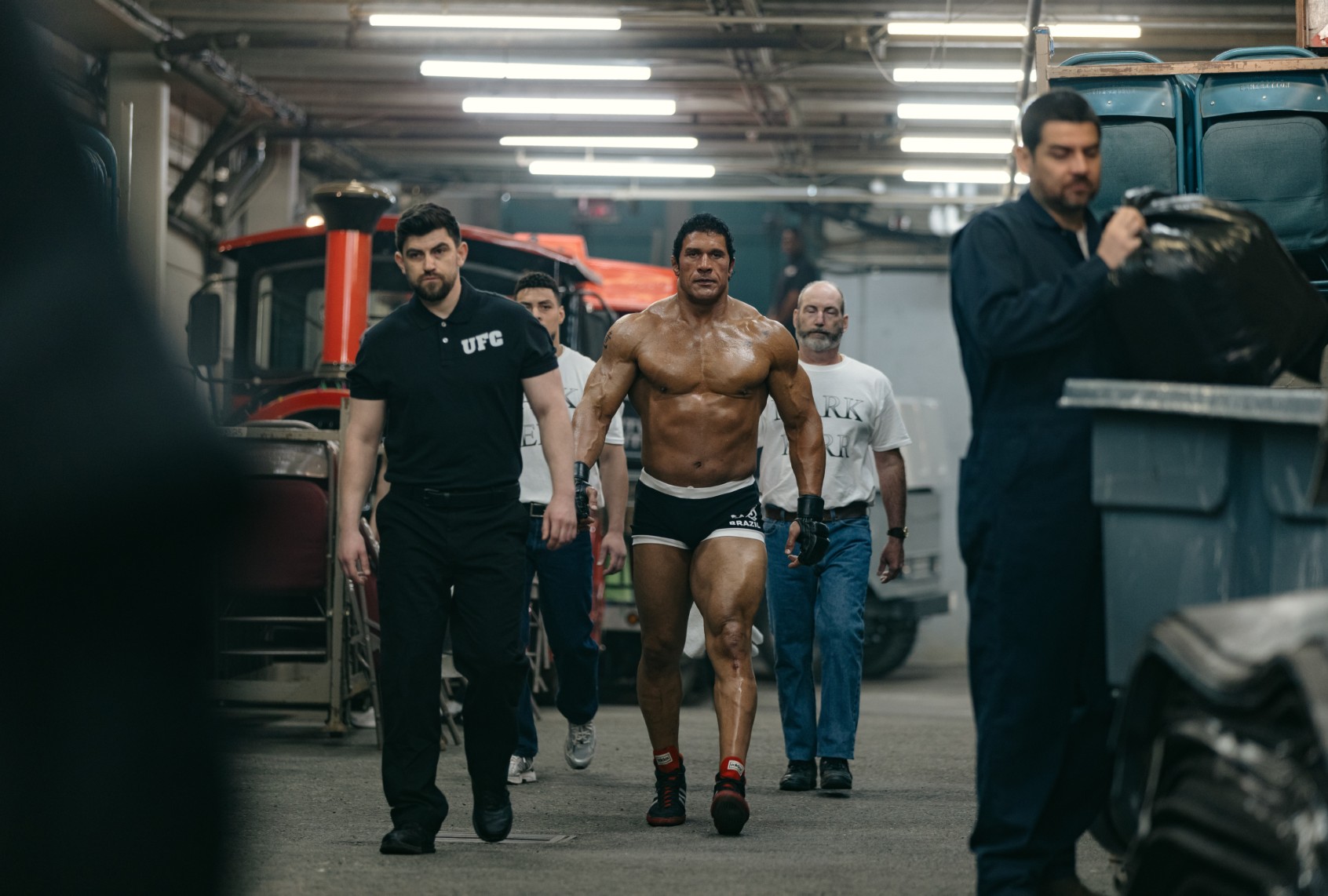Mixed martial arts is a style of full-contact fighting that combines techniques and styles from various sports, including wrestling, judo and jiu-jitsu — you get the picture. All of these sports have their own history and methods; specific forms, procedures and even credos that those who take up the fight swear by. When each sport comes together in an MMA fight, there’s a strange kind of beauty to the violence, an excitement that stems from the unpredictability of each fighter and their chosen style. The combat is real and lyrical, like a melody where each move is a note that must land in the right spot to pull off a win.
“The Smashing Machine,” Benny Safdie’s new film about Ultimate Fighting Championship MMA fighter Mark Kerr, tries desperately to score in the same fashion. Safdie’s movie is its own hodgepodge, a combination of formally captivating styles and fascinating ideas that seem as though they should click in the same way that MMA fighting does. Safdie even has his own wildcard warrior in Dwayne “The Rock” Johnson, who, as Kerr, takes on his most challenging role yet. But nothing in “The Smashing Machine” gels or compels in the ways that the sport depicted onscreen so often does. Safdie’s film is not really a sports movie and barely a biopic, and to call it a character study even seems generous when the very real people portrayed are written so thinly they threaten to disappear. And yet, even for its near-total lack of narrative and emotional thrust throughout, “The Smashing Machine” is frequently buttressed by its unassailable visual elegance and Johnson’s commendable performance, two components that feel like the occasional one-two punch of a fighter not ready to give up. But in its exhausting pursuit of technical perfection, “The Smashing Machine” merely mirrors its subject’s journey, losing sight of its goal for a futile shot at glory.
(Eric Zachanowich/A24) Dwayne Johnson in “The Smashing Machine”
Both Mark and “The Smashing Machine” rely on charm and appearances to fool their audience, hoping Johnson’s stature will be so imposing that viewers won’t want to look past him and catch a glimpse of rickety, glued-together popsicle sticks the narrative is built on.
Like Kerr, “The Smashing Machine” is on a charm offensive. The film is shot on 16mm film, with occasional use of IMAX 70mm and video for key scenes meant to evoke the style of televised fights in the late ’90s. From its opening sequence, where Johnson’s Kerr blasts through a chintzy Egyptian pyramid to enter the ring at an early fight in Brazil, the movie looks fantastic. Not only is Safdie aiming for a period-specific style, but he’s pulling it off with undeniable poise. At times, it’s easy to forget what’s happening within the film itself just because of how nice it is to watch Safdie’s expert photography unfold before your eyes. How could something that looks so good and feels genuinely inspiring just by being in its proximity be deceiving?
As Mark quickly reminds us, quite easily. From his initial interviews with reporters to his conversations with fellow fighters, Mark is kind and collected, an all-around good guy whose amiable manner belies his capacity for violence. Even bloodied and beaten, sitting in the waiting room at his doctor’s office, Mark is a gentle giant, concisely explaining the sport to an older woman sitting across from him, and scribbling his signature onto a paper for her grandson. In matches, Mark’s genial nature can surprise his opponents. But outside of fights, he uses his kindness as a tool to fuel his increasingly dire opioid addiction. After all, the stereotypical junkie probably wouldn’t turn a clinic’s waiting room into an autograph signing.
“Don’t worry about transferring the prescription to Safeway,” Mark tells a nurse after his appointment. “They’re terrible with the insurance; it’s just more work for you. I’ll pay out of pocket.” What seems like a kind gesture is really just the seed of a favor being planted, one Mark calls upon days later when he contacts the nurse for a stronger dose of his favorite injectable painkiller.
Both Mark and “The Smashing Machine” rely on charm and appearances to fool their audience, hoping Johnson’s stature will be so imposing that viewers won’t want to look past him and catch a glimpse of rickety, glued-together popsicle sticks the narrative is built on. And for a while, the spell works, largely thanks to Johnson, who has essentially spent his entire career — from WWE wrestler to bona fide movie star — preparing for a role like this. Johnson learned how to fake it in the ring so he could make it in Hollywood, but none of his films have ever called for him to be so multidimensional. And here, he settles nicely into Kerr’s conflicted state of mind, rattled by drugs, fights, ambition and a constant belief in human kindness that makes his performance engrossing, even when the film isn’t. To say Johnson does a lot with very little would be an understatement, and if this is his road to Oscar (and the use of prosthetics to look more like Kerr would suggest it’s trying to be), it wouldn’t be an undeserved nomination.

(Eric Zachanowich/A24) Emily Blunt and Dwayne Johnson in “The Smashing Machine”
As soon as Dawn’s joy began, mine ended, and the character was again relegated to a cursory sketch of a doting athlete’s girlfriend, depressingly in line with overly masculine portrayals of women in early millennium sports films. By the end, when Dawn tells Mark, “You don’t know a thing about me,” I could do nothing but agree.
If only Johnson’s complexity were matched anywhere else in the screenplay. Had that been the case, “The Smashing Machine” might have had a shot at operating at the level of its capable star. But because Mark spends so much of the film around his on-again-off-again girlfriend, Dawn (Emily Blunt), it’s far easier to notice the gaping flaws in Safdie’s character writing. Dawn is as skin-deep as it gets, a character with no discernible motives and a frustrating absence of realism in a film that’s desperately aiming for authenticity. We’re not afforded the chance to know much about Dawn other than that she is beleaguered by her relationship with Mark, doing all she can to be his caretaker and his rock, only getting flashes of that love in return.
Start your day with essential news from Salon.Sign up for our free morning newsletter, Crash Course.
Because Blunt and Johnson are both great actors who can rise to the occasion, the viewer understands that Dawn and Mark love each other. But there’s only so much an actor can do with outbursts and tearful platitudes of affection. Those displays are just that: displays. They don’t tell the audience anything about these characters that isn’t written into the script, and Safdie’s screenplay is short of the nuance that a character like Dawn requires to round “The Smashing Machine” out into more than just an exercise in style, clawing at Oscars. Blunt is, to her credit, bringing as much as she can to her character. During a scene at a carnival, where Dawn goes on a zero-gravity ride while Mark chooses to stay outside for fear of an upset stomach, Blunt’s wordless display of levity briefly knocked me off my feet. But just as soon as Dawn’s joy began, mine ended, and the character was again relegated to a cursory sketch of a doting athlete’s girlfriend, depressingly in line with overly masculine portrayals of women in early millennium sports films. By the end, when Dawn tells Mark, “You don’t know a thing about me,” I could do nothing but agree.

(Eric Zachanowich/A24) Dwayne Johnson in “The Smashing Machine”
What’s all the more frustrating is that “The Smashing Machine” is in the service of nothing other than itself. Safdie’s film seems to exist to assert the filmmaker’s style, now apparently separate from his former collaborator and brother, Josh. That an excellent 2002 HBO documentary about Kerr — with the exact same title! — already exists is all the more telling. There’s nothing here that the viewer can’t glean from the documentary, and in fact, the doc is a far more edifying and affecting work than Safdie’s stylish regurgitation.
Perhaps Safdie isn’t trying to do anything more than introduce a new generation to Kerr, and throw out some feeble, last-minute ideas about the ephemerality of violent sports glory, as the film’s ending would suggest. But if that were the case, a cogent narrative could make that point just as well as the facts about Kerr that appear on screen at the end of the film. To make matters worse, these details, customary in a biopic, are stylized to capitalize the characters’ names, just like how they’d be written in the screenplay. It’s a choice that feels almost masturbatory, a covert nod to the fact that this movie exists for no reason other than the fact that someone wanted it to. At the end of the day, that’s the ambition that drives artists to make art and fighters to fight. But in both fields, one must live up to their high-and-mighty ambitions, or risk being laughed out of the ring.
Read more
about recent theatrical releases




























